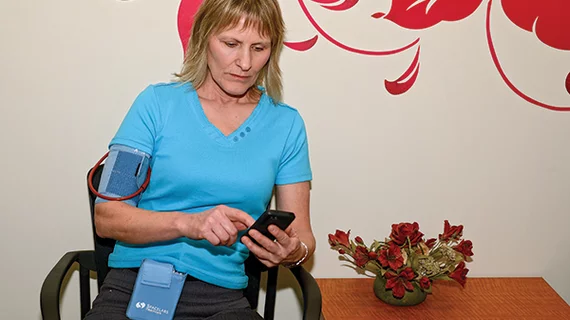A Harvard-led study of 130 hypertensive individuals found a unique home-based blood pressure (BP) control program run by non-physicians can help patients reach healthy BP goals within seven weeks.
Naomi D.L. Fisher, MD, director of the Hypertension Service and Hypertension Specialty Clinic at Brigham and Women’s Hospital, and co-authors said they launched the study in an attempt to raise national rates of controlled hypertension and alleviate some of the physician burden associated with widespread burnout. Today only around half of Americans with high blood pressure have the condition controlled, and that’s using what Fisher and her team called a “lenient” definition of hypertension, at 140/90 mm Hg.
“In addition to substantially increased risk of cardiovascular disease, uncontrolled hypertension generates an enormous burden on healthcare systems,” Fisher and colleagues wrote in Clinical Cardiology. “Traditional office-based management of high BP is inefficient and often ineffective.”
So the researchers devised their own strategy—an at-home BP monitoring system that would be accurate, minimally invasive and could be run by non-physicians. A group of clinical experts and primary care specialists developed an evidence-based titration algorithm for the project, which was based on home BP measurements that would be transmitted automatically to the remote clinical team whenever a patient measured their blood pressure. The algorithm then provided the team with dosing suggestions based on ACC/AHA and NICE guidelines and strategies to improve medication adherence in patients.
In the pilot study, 130 patients with a BP of 140/90 mm Hg or higher were enrolled from one primary care clinic at Brigham and Women’s and provided with a Bluetooth-enabled BP device. Twice a day for one week participants were asked to measure their blood pressure using the device, which was pre-paired with the patient’s electronic medical record for easy data transmission.
Non-licensed patient navigators—trained previously in the algorithm by nurse practitioners and pharmacists—were then able to help patients handle the basics of hypertension management, including treatment guidelines like limiting sodium intake, consuming a balanced diet and losing weight. Progress was tracked using medication titrations, performed over the phone at biweekly intervals until a patient’s BP reached 135/85 mm Hg.
After six months of follow-up, Fisher and co-authors said 81 percent of the original group had reached their goal BP, though some patients’ data was limited due to white coat hypertension, resistant hypertension or insufficient engagement. Of the 116 who consistently took measurements, 91 percent reached their BP goal in an average of seven weeks.
“This remote BP management program addresses several limitations of the current care system, including poor patient identification, therapeutic inertia, significant delays in medication titration and lack of patient engagement or involvement,” Fisher et al. wrote, noting the program improved hypertension control rates more quickly and cost-effectively than most traditional strategies.
Hypertension control was also reached in the study population without a large increase in pill burden—the average number of medications a patient took from baseline to control rose only modestly, from 1.4 to 1.8. Amlodipine, a hypertension and angina drug also known as Norvasc, was the most common new medication.
The authors said higher rates of BP control are only possible with more patient engagement, which their model facilitates. By incorporating patient navigators into the mix, Fisher and colleagues were freeing up doctors’ time and providing patients with constant points of contact who can also serve as motivators and educators.
“The time-honored model of treating hypertension through traditional visits to the doctor is neither effective nor sustainable,” Fisher and co-authors wrote. “New guidelines that target even lower BP goals will require the development of innovative solutions to manage hypertension effectively and efficiently, and thus reduce the cardiovascular risk burden in larger populations. A home-based BP control program run by non-physicians can provide efficient, effective and rapid control, suggesting an innovative paradigm for hypertension management.”

